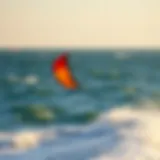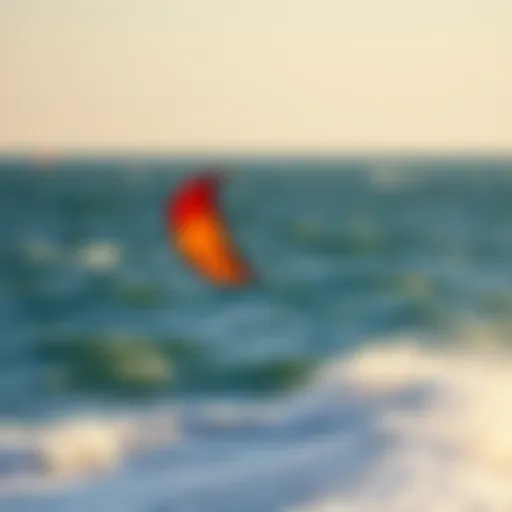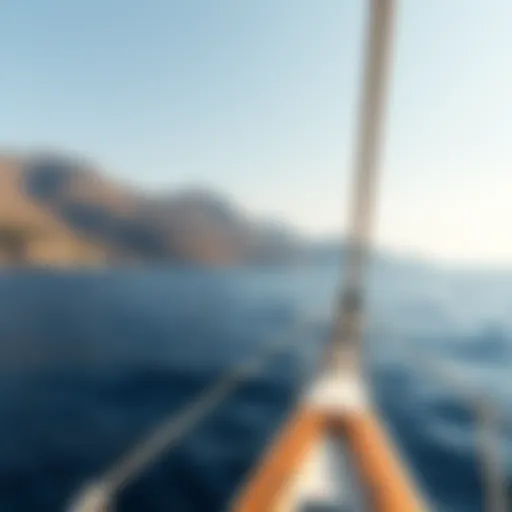Eugene Weather Insights: A Guide for Kiteboarders


Intro
Weather in Eugene, Oregon, offers a tapestry woven from the streams and rivers of the Pacific Northwest. To understand kiteboarding and ensure those soaring moments are smooth and enjoyable, one must comprehend how the climate paints this landscape. The National Oceanic and Atmospheric Administration (NOAA) plays a crucial role in providing data that helps both enthusiasts and professionals make informed decisions based on Eugene's unique weather patterns. With winds that can shift from gentle breezes to gusty surprises, the insights gleaned from NOAA can prepare kiteboarders to harness the perfect conditions.
Local weather is not merely a backdrop but the main character in the kiteboarding story. Factors like temperature fluctuations, wind speeds, and precipitation patterns heavily influence the experience on the water. This article aims to unravel these complexities, emphasizing the relevance of weather for both practical kiteboarding tactics and safety measures. By diving into historical data, current forecasts, and practical recommendations for gear and techniques, we aim to empower readers with the knowledge essential for making the most out of their kiteboarding adventures in Eugene.
Understanding NOAA's Role in Weather Forecasting
The effectiveness of weather forecasting in the United States largely hinges on the resources and expertise provided by the National Oceanic and Atmospheric Administration, known as NOAA. In analyzing the specific climatic conditions of Eugene, Oregon, it becomes paramount to grasp how NOAA functions and its ramifications on local weather understanding. This section seeks to break down the core elements of NOAA's role, emphasizing the benefits for residents and visitors alike, particularly those intrigued by outdoor activities like kiteboarding.
What is NOAA?
The National Oceanic and Atmospheric Administration is a scientific agency within the U.S. Department of Commerce. Established in 1970, its mission encompasses a broad spectrum of environmental monitoring, including atmospheric and oceanic observations. NOAA specializes in a range of areas such as weather prediction, climate monitoring, and ocean exploration.
Much of what NOAA provides hinges on meticulous research and data collection from both ground and satellite sources, giving it the edge in delivering timely and accurate forecasts. Notably, the agency’s vast network of weather observers and sophisticated predictive models make it an indispensable resource.
NOAA serves various sectors beyond just weather lovers; from agriculture to disaster preparedness, its functions influence many aspects of daily life. This wide scope ensures that the community can rely on NOAA’s detailed insights to make informed decisions, whether it's for farming schedules or planning outdoor events.
NOAA's Impact on Local Weather
In Eugene, the influence of NOAA is felt most acutely through its weather services. The agency’s local offices regularly disseminate crucial information that helps residents and enthusiasts understand their unique microclimate. For instance, Eugene's proximity to the Pacific Ocean results in specific weather patterns that vary dramatically based on factors such as elevation and proximity to bodies of water.
A few key areas where NOAA’s impact manifests include:
- Localized Forecasting: Accurate, area-specific weather alerts keeping kiteboarders informed on changing conditions, winds, and temperature fluctuations.
- Historical Data Analysis: Ongoing assessments of past weather events, allowing kiteboard enthusiasts to prepare by understanding what conditions led to the best—and worst—kiteboarding days. This can be invaluable for planning.
- Educational Outreach: NOAA also engages with local communities to imbue them with knowledge regarding weather safety and preparedness, which can be particularly beneficial for adventure sports.
"NOAA's insights into Eugene's weather patterns not only enhance recreational experiences but fortify safety protocols in outdoor activities."
Furthermore, the NOAA website acts as a treasure trove of resources—allowing local residents and visitors alike to tap into a wealth of data. From wind speed measurements to detailed forecasts and storm tracking, understanding this information can elevate kiteboarding experiences while ensuring those who sail into the wind remain safe and informed.
In summary, NOAA's robust suite of monitoring capabilities directly correlates with the quality of life in Eugene. By equipping the community with reliable forecasts and historical contexts, NOAA empowers local adventurers to maximize their enjoyment of kiteboarding while minimizing risks associated with variable weather conditions.
Weather Patterns in Eugene, Oregon
Understanding the weather patterns in Eugene, Oregon, is crucial not just for the average resident, but particularly for enthusiasts of kiteboarding. Eugene's climate is characterized by a unique mix of factors that directly affect local activities, shaping the experience for kiteboarders and outdoor adventurers alike. By studying these patterns, individuals can make informed decisions about when to hit the water, optimize their enjoyment, and prioritize safety. This section delves into significant weather events, typical temperature ranges, and the precipitation trends that define Eugene's weather landscape.
Historically Significant Weather Events
Eugene has seen its share of extraordinary weather events over the years, which serve as benchmarks for understanding both local climate and the increasing impact of climate change. One such event was the winter of 1964, when the Willamette River flooded, leading to substantial damage in various neighborhoods. This event highlights the region's potential for extreme weather—something local kiteboarders should keep in mind during stormy seasons.
Additionally, in 1996, a record-setting storm delivered heavy rainfall, causing even more flooding and affecting local waterways. Events like these provide essential context for anyone looking to engage in water sports, as they underline that conditions can change rapidly and it’s important to stay alert and informed.
"Eugene's weather may often be mild, but it can turn on a dime, making historical events a lesson in preparedness."
Average Temperature Ranges
Eugene experiences a temperate climate, which is predominantly influenced by its position in the Pacific Northwest. Average temperatures fluctuate significantly throughout the year. Winters can see lows averaging around 30°F in December and January, while summers can rise to an agreeable average of about 80°F in July and August.
For kiteboarders, the summer months are particularly appealing, not just for the warmth, but for the stable wind conditions that often accompany higher temperatures. Throughout spring and fall, temperatures remain mild, often hovering between 50°F and 70°F. Keeping track of these averages is crucial for those wanting to hit the water, as sudden temperature drops or heat spikes can impact both human comfort and equipment performance.
Precipitation Trends
Rain is a hallmark of Eugene's weather system, with the area receiving an average of over 40 inches annually. Most of this precipitation falls during the winter months, particularly from November through March. This can create challenging conditions for both kiteboarding and general outdoor activities.
However, awareness of these trends allows kiteboarders to plan their outings carefully, considering that during the drier summer months, the chances of precipitation decrease significantly. Understanding the timing and volume of rainfall can help in predicting the water conditions on local rivers and lakes, which can be vital for a good day on the board.
Being prepared for Eugene's weather—and knowing how historical data can guide current practices—can greatly influence kiteboarding experiences, making them safer and more enjoyable. Enthusiasts are encouraged to stay updated on current conditions and trends through resources such as NOAA and local meteorological services.
Current Weather Conditions in Eugene
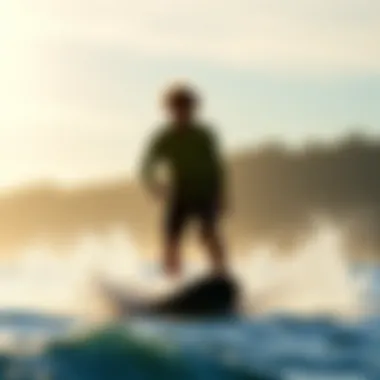
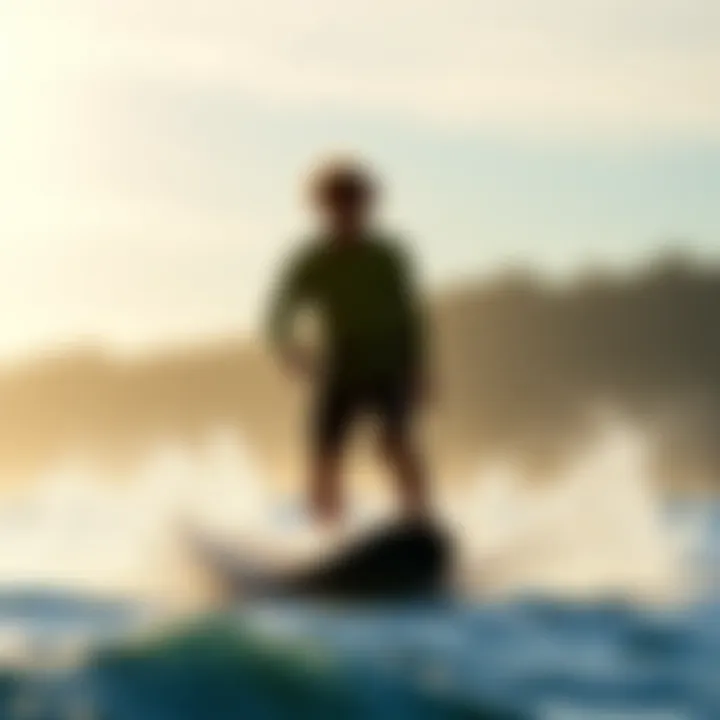
Understanding the current weather conditions in Eugene is integral not only for residents but also for outdoor enthusiasts, particularly kiteboarders. Accurate, real-time data can make all the difference between a thrilling day on the water or a disappointing one spent on dry land. Factors like wind speed, temperature, and humidity can shift rapidly in this region, influenced by its unique geographical features. With the National Oceanic and Atmospheric Administration (NOAA) providing timely updates, kiteboarders can harness this information to ensure they enjoy the ideal conditions for their sport.
Real-time weather observations help enthusiasts optimize their planning. Imagine preparing for a kiteboarding adventure, only to discover that wind patterns have shifted dramatically just hours before your outing. Having access to current weather data alleviates such uncertainties, allowing kiteboarders to adjust their plans easily. Also, understanding these conditions can directly inform decisions about what equipment to utilize, enhancing safety and performance during sessions.
Real-Time Data from NOAA
NOAA's commitment to providing real-time meteorological data is central to how Eugene residents and visitors prepare for varying weather conditions. The agency offers a suite of tools that deliver up-to-the-minute information. For kiteboarders, the sleek interface of NOAA's website and its mobile application presents critical parameters essential for smooth sailing on the water.
By checking wind conditions, for example, kiteboarders can assess if the breeze is potentially ideal for their skill level, helping them to gauge whether it's time to set sail or wait for a better afternoon gust. Moreover, NOAA provides detailed forecasts with specific metrics:
- Wind Speeds: Vital for kiteboarding, knowing both sustained winds and gust speeds allows kiteboarders to select appropriate gear.
- Wave Height and Water Temperature: These are significant for safety and comfort, enabling kiteboarders to choose the right wetsuits and gear.
- UV Index: A critical factor to consider during summer months to ensure skin protection.
These elements are vital for a safe, enjoyable kiteboarding experience.
Understanding Weather Alerts
Weather alerts serve as a crucial tool in maintaining safety while kiteboarding in Eugene. NOAA's alert system dives into parameters that define risk levels, helping outdoor enthusiasts understand potential threats. Whether it’s a sudden shift in wind causing turbulence or impending storms that can churn up dangerous water conditions, timely alerts can save lives.
There are different types of alerts from NOAA:
- Severe Thunderstorm Warnings – could indicate turbulent winds and rain, which disrupt kiteboarding conditions.
- High Wind Warnings – crucial for kiteboarders to make quick decisions about heading out or staying back, as strong winds can pose a dangerous threat on the water.
- Flood Watches – in case of heavy rainfall, these alerts signify risks of water rising rapidly, making certain areas unsafe.
Being attuned to these alerts helps kiteboarders not only plan better but also react quickly to fluctuating conditions, enhancing both their enjoyment and safety on the water. In one simple act of checking alerts, a kiteboarder can ensure their experience is rewarding rather than reckless.
Forecasting Weather: Techniques and Tools
Weather forecasting is more than just a prediction; it's a science tailored for those who seek to understand the intricate dance of forces that shape our climate. For kiteboarders in Eugene, knowing how to leverage various forecasting techniques and tools can be a game-changer. As winds shift and storms brew, having the right insights allows enthusiasts to maximize their time on the water while minimizing risks.
Analyzing Forecast Models
Forecast models serve as the backbone of meteorological predictions. These models use complex algorithms and vast datasets, pulling from various sources that include past weather patterns and current atmospheric conditions. In Eugene specifically, these models are particularly beneficial due to the region's unique microclimates influenced by the nearby mountains and rivers.
When examining these models, you could consider:
- Numerical Weather Prediction (NWP): This approach utilizes mathematical equations to simulate the atmosphere and predict where weather patterns are heading. NWP models like the Global Forecast System (GFS) and the North American Mesoscale (NAM) offer detailed insights about the upcoming weather. Kiteboarders can rely on these models for wind speed and direction forecasts, crucial for their activities.
- Ensemble Forecasting: Often, one model prediction might not be enough. Ensemble forecasting runs multiple models simultaneously to gauge a range of possible outcomes, giving kiteboarders a sense of uncertainty in forecasts. One might say, it’s like having multiple fishing lines in the water to catch that big wave!
In practical terms, monitoring these models could mean the difference between a mediocre session or catching the perfect gust. Much like reading the winds before a session, diving into these data-rich visualizations empowers kiteboarders to make informed decisions.
The Role of Satellites in Monitoring Weather
Satellites have revolutionized how we understand weather patterns. With their eye in the sky, they give us a real-time glimpse of evolving weather systems that ground-based observations may miss. In Eugene, satellite data provides kiteboarders with actionable insights right before they hit the water.
Key points about satellite monitoring include:
- High-Resolution Images: Modern satellites capture detailed images of cloud formations and storm systems. These images help in predicting the onset of storms which can be critical for safety. The National Oceanic and Atmospheric Administration's GOES (Geostationary Operational Environmental Satellite) system is one such vital tool.
- Real-Time Data: Satellites provide real-time information on temperature, humidity, and wind patterns. For kiteboarders, understanding atmospheric conditions can lead to safer and more enjoyable experiences on water. It’s like a heads-up about what kind of ride is waiting out there.
- Data Fusion: Satellite data is combined with ground observations to enhance forecasting accuracy. This fusion results in a clearer picture of changing conditions. Using tools like the National Weather Service's radar can provide up-to-date information crucial for planning kiteboarding sessions.
"One does not simply just step onto a kiteboard without knowing what the winds are doing."
As kiteboarding greatly depends on favorable weather, utilizing satellite data is akin to having a secret weapon in your arsenal for the ultimate ride.
For more insights, consider visiting resources like NOAA’s own data portals NOAA.gov or the National Weather Service Weather.gov for up-to-date satellite imagery.
Combining the advances in forecasting models with satellite technology provides kiteboarders not just with a glimpse of the weather but a comprehensive understanding to navigate Eugene’s various wind and weather conditions.
The Influence of Weather on Kiteboarding
Kiteboarding is not just a sport; it is a dance with the elements. For someone venturing out on the waters of Eugene, understanding the interplay between weather conditions and kiteboarding performance is crucial. This section zooms in on how various weather factors can shape the kiteboarding experience, examining the specific elements that kiteboarders should pay close attention to.
Weather influences kiteboarding in several key ways. Wind is the lifeblood of this sport, dictating not only whether one can launch but also how exhilarating the ride will be. Besides wind, temperature and precipitation can play roles, sometimes shaping safety conditions. Being prepared to read and interpret weather patterns can make the difference between a thrilling session and a mishap.
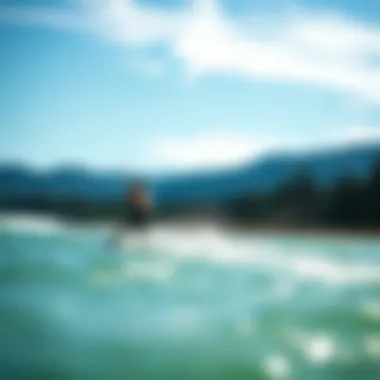
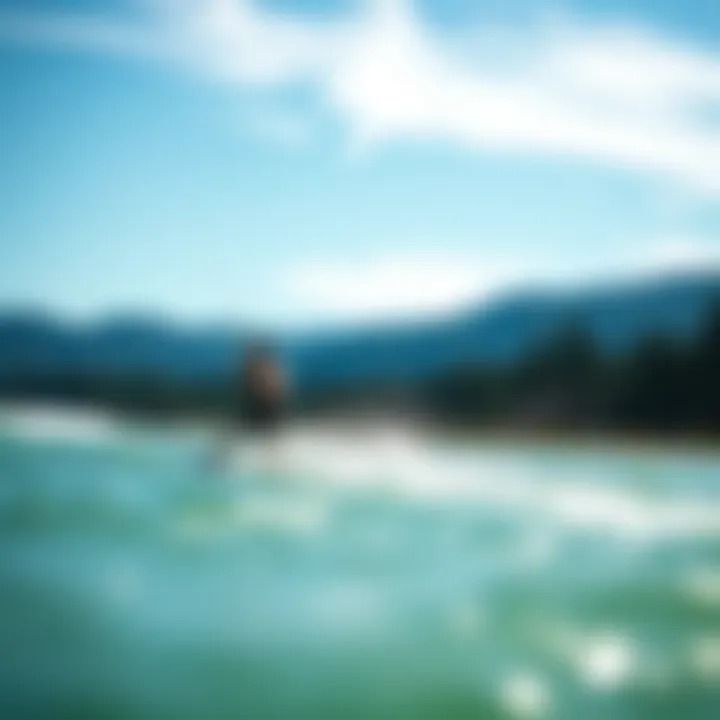
Understanding Wind Patterns
Wind patterns are fundamental for kiteboarding; without the right winds, there’s no kiteboarding. For those who kiteboard in Eugene, recognizing local wind directions and speeds is half the battle won. Generally, kiteboarders prefer consistent winds, typically ranging from 12 to 25 knots, which provide ample lift and maneuverability.
It’s also worth noting that Eugene’s geographical features can impact these wind conditions. The nearby Cascade Mountains can funnel winds, creating localized gusts and lulls. For example:
- Coastal winds tend to be steadier in the afternoon.
- Morning winds might be lighter due to the cool air settling overnight.
- Afternoon thermal winds can bring stronger gusts, perfect for more experienced riders.
One key point to remember is that wind speed can fluctuate throughout the day. An hour on the water during mid-afternoon could feel entirely different than those same conditions just an hour later. This variability is vital for kiteboarders to monitor closely, as effective wind planning can lead to smoother rides.
Identifying Optimal Conditions for Kiteboarding
To enhance the kiteboarding experience, it’s essential to discern optimal weather conditions. Here are several criteria that kiteboarders should assess:
- Wind Speed: Ideal wind speeds typically hover between 15-20 knots for intermediate riders. Novices might fare better with gentler breezes around 12 knots.
- Wind Direction: The preferred wind direction is usually side-onshore, providing a balance between safety and performance. If the winds come from the land side, the 'fetch' of the water can limit the swell and impact.
- Weather Systems: Stable high-pressure systems generally bring clearer skies and consistent winds, while low-pressure systems can lead to unpredictability, including storms.
- Temperature and Comfort: Higher temperatures can affect how you dress and can also influence the water conditions. Colder weather may lead to challenges like shrinkage in your gear or hypothermia.
Evaluating these aspects can empower enthusiasts to seize the right moment for a kiteboarding session. Knowing how to spot favorable conditions also fosters a sense of camaraderie among kiteboarders in the local community.
**"Kiteboarding is all about anticipation. Knowing when to hit the water often hinges on how well you can read the winds and the skies above."
By closely monitoring the local weather through the resources provided by NOAA, kiteboarders can transform their outing into an unforgettable experience while staying safe.
In the end, understanding how weather influences kiteboarding in Eugene offers not just better performance, but a more profound respect for nature itself. Each gust, wave, and current becomes part of the larger conversation between the rider and the environment.
Safety Considerations for Kiteboarding in Varied Weather
Kiteboarding can be thrilling, a dance with the elements that's both exhilarating and demanding. But not all weather is created equal, and knowing when to take to the water is essential. Safety should be a kiteboarder’s mantra, particularly when confronted with unpredictable conditions. Understanding how weather impacts kiteboarding isn't just about enhancing performance; it also shields enthusiasts from unnecessary risks.
Weather conditions—ranging from wind speed to sudden shifts in temperature—can alter rapidly in Eugene. A well-informed kiteboarder is a safe kiteboarder. By keeping an eye on forecasts and understanding local patterns, one can significantly reduce risks while enjoying the sport.
Assessing Risks during Storms
When it comes to storms, kiteboarding is best left for another day. Strong winds, lightning, and rain can approach on a hair-trigger. Storm systems can develop quickly in the Oregon skies, often without much warning. For instance, a calm afternoon can morph into wild gusts in a matter of minutes.
Key Areas to Consider:
- Wind Speeds: Anything above twenty knots can pose challenges, especially if sudden gusts are present. High winds can lead to loss of control, which might endanger you and others nearby.
- Precipitation: Rain can reduce visibility, making it hard to see obstacles or other boarders in the water. It's essential to check forecasts, as even light rain can signal more severe conditions ahead.
- Lightning: If you hear thunder, take it as a clear sign to head for the shore. Staying aware of storm fronts developing can prevent accidents.
A kiteboarder should always err on the side of caution during stormy weather. Sometimes it's better to stay dry and secure than to risk life and limb chasing a fleeting thrill.
Understanding Lightning Safety Protocols
Lightning is a formidable force of nature—fast, powerful, and deadly. Kiteboarding, with its height and conductive materials, puts enthusiasts at a considerable risk if caught under stormy skies.
- Seek Shelter: If you hear thunder or spot flash in the distance, find a sturdy shelter immediately. Stay away from tall objects, water, and metal structures.
- Wait it Out: Safety protocols suggest waiting at least thirty minutes after the last rumble of thunder before returning to the water. Storms can linger, and lightning strikes can occur even when it appears to be over.
- Educate Yourself: Familiarize yourself with the area. Know where local shelters are, or have a plan set if the weather turns uncooperative during your time on the board.
Leveraging NOAA Resources for Kiteboarders
Navigating the complexities of weather can make or break a kiteboarding outing. Understanding how to effectively leverage resources from the National Oceanic and Atmospheric Administration (NOAA) becomes crucial for kiteboarders aiming to enhance their experiences on the water. One of the core aspects is the access to detailed and up-to-date weather information, which is indispensable for ensuring safety and maximizing performance.
Not only does NOAA provide real-time data, but it also offers historical weather patterns, which can prove invaluable in predicting future conditions. The benefits of utilizing NOAA resources are numerous:
- Real-time Updates: Live data helps in tracking changing conditions, making it easier to avoid unfavorable weather.
- Informed Decision-Making: Access to comprehensive forecasts allows kiteboarders to analyze when to hit the water for the best conditions.
- Safety Alerts: NOAA issues weather warnings and alerts, ensuring kiteboarders remain informed about potential dangers, thus minimizing risks while enjoying their sport.
- Accessible Data: The user-friendly NOAA website and applications provide easy access to the vital information one needs.
When kiteboarders understand how to utilize these resources effectively, they can approach their sport with the right preparation and awareness, leading to more fruitful and enjoyable outings.
Navigating the NOAA Website for Local Data
The NOAA website serves as a treasure trove for kiteboarders seeking local weather insights. To get started, simply visit NOAA's main website. From there, the following steps will help in finding relevant data:
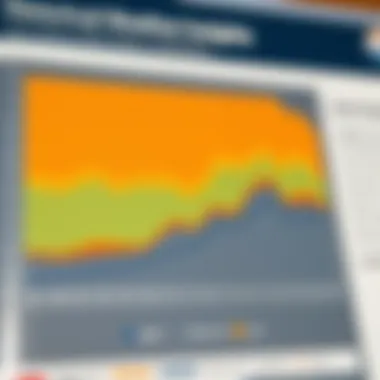
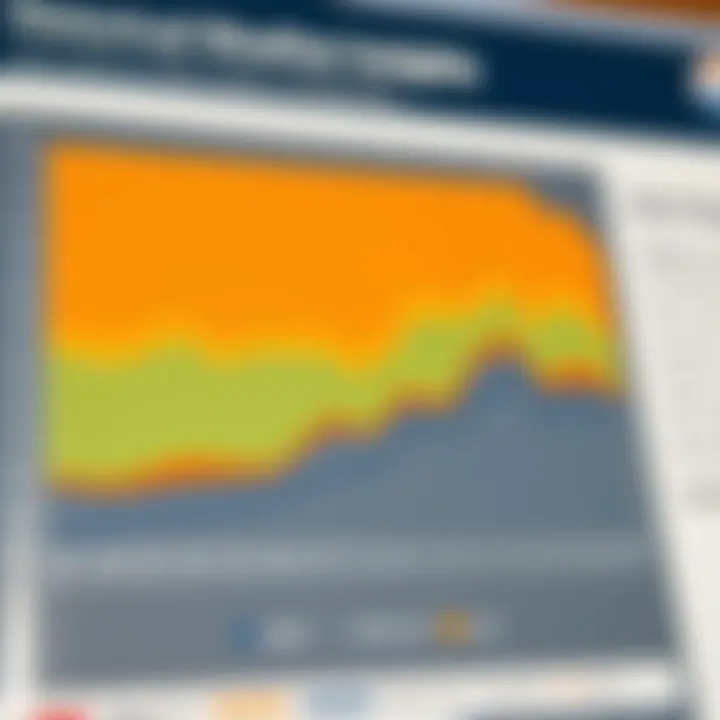
- Select Your Region: Use the interactive map to zoom into Eugene, Oregon, allowing you to access localized weather data.
- Real-time Radar and Satellite Imagery: Check the radar section to view current weather patterns and shifts in real-time.
- Detailed Forecasts: Find daily and weekly forecasts presented in a user-friendly manner, breaking down temperature, wind speeds, and precipitation.
- Weather Alerts: Stay updated with any warnings that could impact kiteboarding sessions, such as high winds or storms.
With these tools at hand, kiteboarders can make informed choices about the best times to enjoy their sport without running afoul of inclement conditions.
Utilizing Mobile Apps for Real-Time Updates
In today's fast-paced world, mobile applications are the name of the game, especially for on-the-go kiteboarders. NOAA has developed an array of applications that translate crucial weather information into accessible formats. Here’s how these apps can aid kiteboarders:
- Instant Notifications: Receive push notifications about significant weather changes, ensuring that you’re always in the loop, no matter where you are.
- User-friendly Interface: The apps are designed to be intuitive, making it simpler to comprehend complex weather phenomena at a glance.
- Customizable Data: Users can tailor the types of alerts and data they wish to receive, focusing specifically on parameters important for kiteboarding, like wind speed and gusts.
For a comprehensive insight, recommended apps include:
- NOAA Weather Radar Live: Offers real-time weather radar and alerts.
- Windy: Focuses on wind conditions, making it a go-to for kiteboarders.
By leveraging mobile apps alongside the NOAA website, kiteboarders can engage with their sport dynamically and responsively, ensuring they catch the best weather when it counts.
Community Insights: Local Kiteboarding Experiences
When it comes to kiteboarding in Eugene, community is at the heart of the experience. The importance of community insights can't be overstated. Local kiteboarders possess firsthand knowledge about conditions, setups, and nuances that guides aren't always privy to. This real-world experience creates a wealth of information that's invaluable to both newcomers and seasoned enthusiasts. One can often gain insights into weather patterns, best times to hit the water, and even safety tips, all catered to the local landscape. For the kiteboarding crowd, being part of such a network fosters a sense of belonging, making it that much easier to navigate the ups and downs of both the sport and the weather.
Additionally, understanding local experiences helps kiteboarding enthusiasts anticipate challenges that might not make it into official forecasts. Things like unexpected wind shifts or sudden changes in water levels can catch an unprepared rider off guard. It's this shared knowledge that breeds confidence across the community, ensuring everyone can enjoy the thrill of riding while remaining safe. Plus, veterans can help newcomers avoid pitfalls, turning what might have been a harsh learning curve into a smooth ride. The importance of community insights lays the groundwork for safer and more enjoyable kiteboarding sessions in Eugene.
Sharing Knowledge and Tips
In the realm of kiteboarding, the act of sharing knowledge is crucial. Local kiteboarders often come together in forums, either online or in-person, to exchange tips and best practices. This collaborative spirit encompasses a wide array of topics. For instance, one might learn about the best launch spots, local regulations, or simply the best gear that withstands the unique winds of Eugene.
Here's a glimpse of what free tips typically cover:
- Local Launch and Landing Spots: Understanding where to start and end your sessions can make a big difference. It's about safety and maximizing your time on the water.
- Gear Recommendations: Kiteboarding gear can be personal. However, community members can recommend brands or specific equipment that works well under Eugene's conditions, sharing their own trial and error stories.
- Wind Insights: Local kiteboarders can provide insights into the often fickle winds of Eugene. Knowing when conditions are right for your skill level truly elevates the experience.
"The happiness of kiteboarding is not just in the ride, it's in the friendships you make along the way."
Sharing experiences turns learning from a tedious task into an enjoyable mission. With the right tips, even the latest beginner can be up and flying in no time.
Building a Supportive Kiteboarding Network
Building a supportive kiteboarding network in Eugene isn't merely beneficial; it’s essential. Many locals are eager to pave the way for newcomers and enthusiasts alike. A strong network ensures that kiteboarders of all levels have access to help, advice, and camaraderie. This sense of network manifests in various ways.
Consider the collective meet-ups at popular kiteboarding spots like Dexter Lake or the Siuslaw River. These gatherings serve dual purposes: a chance to ride together and create bonds with others who share the same passion. Events, whether casual get-togethers or more organized practices, build solidarity.
Key elements of a supportive network include:
- Mentorship Opportunities: Experienced kiteboarders often step up to guide those less experienced, reducing the learning curve.
- Social Media Groups: Platforms like Facebook host groups dedicated to Eugene kiteboarding. Here people can seek advice, share videos, and keep each other updated on the latest conditions.
- Events and Competitions: Engaging in local competitions not only raises skills but also fosters friendships. Every winner celebrates together, and every participant builds a chance to connect.
The power of collaboration and support can turn an individual sport into a community affair, allowing all kiteboarders in Eugene to ride the wind with better knowledge and greater confidence. With a strong community backing them, riders can lift their kites and spirits together.
Future Trends in Weather Forecasting
The landscape of weather forecasting is steadily evolving, particularly as technology continues to advance. For kiteboarders and outdoor enthusiasts in Eugene, understanding these future trends can be critical not just for enjoyment, but for safety too. The importance of keeping abreast of these developments cannot be overstated. Whether it's having a reliable forecast for planned outings or being prepared for sudden weather changes, knowing what lies ahead offers substantial benefits.
Advancements in Meteorological Science
Innovations in meteorological science are paving the way for more accurate and localized forecasts. One recent advancement includes the increasing use of machine learning models that analyze vast datasets far quicker and more efficiently than traditional methods. These models can predict weather patterns with unprecedented precision, giving kiteboarders in Eugene a better shot at hitting those optimal conditions.
Another key element is the integration of artificial intelligence in weather prediction. This technology enhances the accuracy of forecasting by identifying patterns human meteorologists often miss. By utilizing AI, forecasters can provide detailed analyses that address the specific needs of kiteboarders, such as wind strength and direction. With these advancements, understanding the weather becomes less guessing and more data-driven, ensuring that everyone can make informed decisions before heading out on the water.
The Evolution of Climate Monitoring Systems
The evolution of climate monitoring systems also plays an essential role in understanding weather trends. Modern systems utilize satellite technology to gather real-time data about regional climates and local weather phenomena. For kiteboarders, this means access to up-to-date information on wind velocities and precipitation forecasts, helping to shape their day-to-day activities.
Moreover, the rise of the Internet of Things (IoT) has led to the proliferation of various weather-monitoring devices in homes and on the water. Systems that relay immediate environmental data like temperature and wind speed help users adapt quickly to their surroundings, enabling them to choose the best times for kiteboarding.
"Today's advancements lay the groundwork for a new era of safety and preparation in outdoor activities, especially when it comes to spontaneous sports like kiteboarding."
In summary, future trends in weather forecasting—bundling advancements in meteorological science with enhanced climate monitoring systems—create a dynamic environment for sailors and kiteboarders in Eugene. Keeping a watchful eye on these developments will equip adventurers with tools for better decision-making, ensuring a safer and more thrilling experience on the water.
